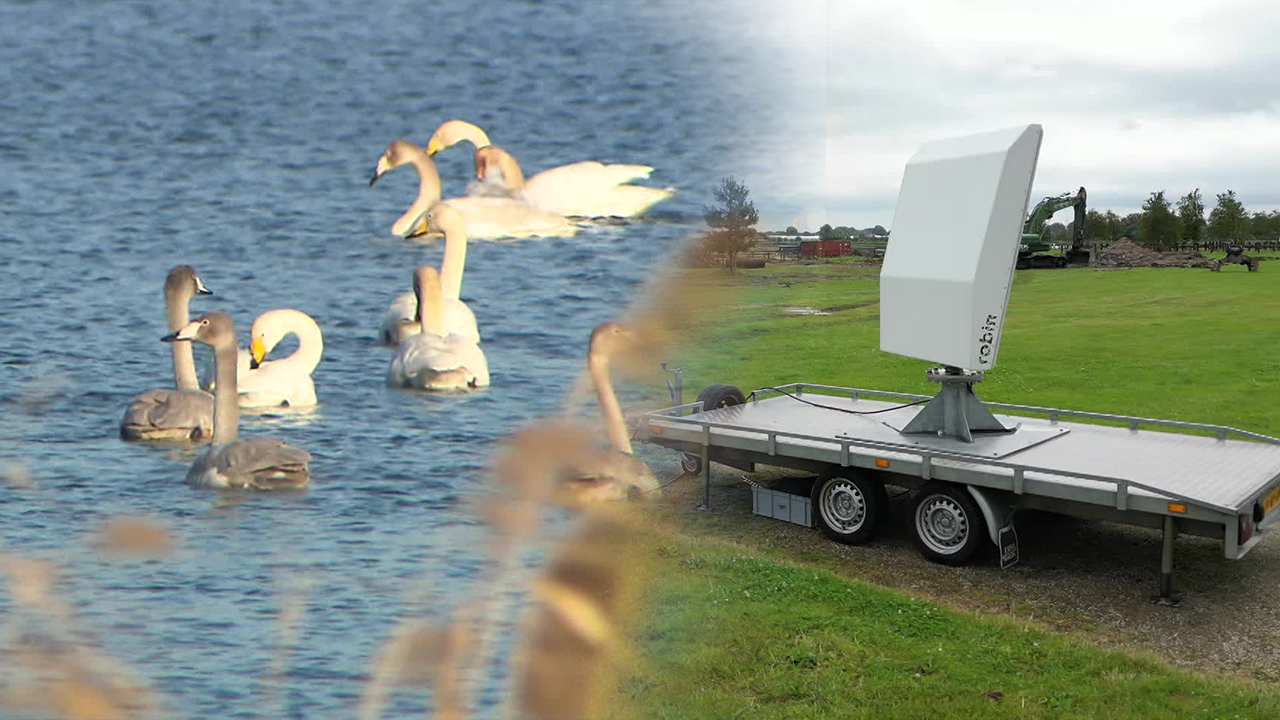Bird radar recommended for bird strikes at airports
입력 2025.01.01 (04:44)
읽어주기 기능은 크롬기반의
브라우저에서만 사용하실 수 있습니다.
[Anchor]
This is a bird detection radar installed at Seattle-Tacoma International Airport in the United States.
The radar detects the location, speed, and direction of birds to prevent collision accidents with aircraft.
It can also store bird activity data and analyze patterns.
It has been introduced at airports in the United States and Europe, but there are currently no such systems at domestic civilian airports, except for the Seosan Airbase.
While the detection rate is not high when one or two birds fly in, there are calls to consider its introduction given the increasing frequency of bird strikes.
Following the incident at Muan Airport, concerns about bird strikes at other airports are also growing.
First, we looked into the situation at Gimhae Airport.
This is Jeong Hyung-seo reporting.
[Report]
Flames erupt from the right engine of a passenger plane.
It is presumed that a bird was sucked into the engine.
Gimhae Airport is also exposed to a high risk of bird strike accidents.
This is because the Nakdong River estuary, the largest migratory bird habitat in the country, is located near Gimhae Airport.
Every year, about 170,000 migratory birds, including relatively large swans, cranes, and geese, visit this area.
From 2019 to August of this year, the number of bird strikes at Gimhae Airport totaled 147, the highest among 14 regional airports nationwide.
[Kwon Ki-joo/Gyeongnam Gimhae City: "There seem to be a lot of migratory birds, and because of that, many people are stationed at the airport to shoot at the birds."]
Korea Airports Corporation and the Air Force have deployed 32 dedicated personnel at Gimhae Airport to chase away flocks of birds flying into the airport.
However, monitoring birds moving from outside the airport is limited to issuing alerts through visual observation.
There are calls for the urgent introduction of 'bird detection radar' that can detect bird movements from a relatively long distance and issue alerts.
[Hyun Dong-seon/Former Air Force 20th Fighter Wing Bird Control Officer: "The bird detection radar can monitor up to 12 km, so pilots can be sufficiently advised and take action."]
The installation cost of bird detection radar is about 3 billion won per unit.
Apart from Incheon Airport, other domestic airports have not even begun to consider its introduction.
This is Jeong Hyung-seo from KBS News.
This is a bird detection radar installed at Seattle-Tacoma International Airport in the United States.
The radar detects the location, speed, and direction of birds to prevent collision accidents with aircraft.
It can also store bird activity data and analyze patterns.
It has been introduced at airports in the United States and Europe, but there are currently no such systems at domestic civilian airports, except for the Seosan Airbase.
While the detection rate is not high when one or two birds fly in, there are calls to consider its introduction given the increasing frequency of bird strikes.
Following the incident at Muan Airport, concerns about bird strikes at other airports are also growing.
First, we looked into the situation at Gimhae Airport.
This is Jeong Hyung-seo reporting.
[Report]
Flames erupt from the right engine of a passenger plane.
It is presumed that a bird was sucked into the engine.
Gimhae Airport is also exposed to a high risk of bird strike accidents.
This is because the Nakdong River estuary, the largest migratory bird habitat in the country, is located near Gimhae Airport.
Every year, about 170,000 migratory birds, including relatively large swans, cranes, and geese, visit this area.
From 2019 to August of this year, the number of bird strikes at Gimhae Airport totaled 147, the highest among 14 regional airports nationwide.
[Kwon Ki-joo/Gyeongnam Gimhae City: "There seem to be a lot of migratory birds, and because of that, many people are stationed at the airport to shoot at the birds."]
Korea Airports Corporation and the Air Force have deployed 32 dedicated personnel at Gimhae Airport to chase away flocks of birds flying into the airport.
However, monitoring birds moving from outside the airport is limited to issuing alerts through visual observation.
There are calls for the urgent introduction of 'bird detection radar' that can detect bird movements from a relatively long distance and issue alerts.
[Hyun Dong-seon/Former Air Force 20th Fighter Wing Bird Control Officer: "The bird detection radar can monitor up to 12 km, so pilots can be sufficiently advised and take action."]
The installation cost of bird detection radar is about 3 billion won per unit.
Apart from Incheon Airport, other domestic airports have not even begun to consider its introduction.
This is Jeong Hyung-seo from KBS News.
■ 제보하기
▷ 카카오톡 : 'KBS제보' 검색, 채널 추가
▷ 전화 : 02-781-1234, 4444
▷ 이메일 : kbs1234@kbs.co.kr
▷ 유튜브, 네이버, 카카오에서도 KBS뉴스를 구독해주세요!
- Bird radar recommended for bird strikes at airports
-
- 입력 2025-01-01 04:44:40

[Anchor]
This is a bird detection radar installed at Seattle-Tacoma International Airport in the United States.
The radar detects the location, speed, and direction of birds to prevent collision accidents with aircraft.
It can also store bird activity data and analyze patterns.
It has been introduced at airports in the United States and Europe, but there are currently no such systems at domestic civilian airports, except for the Seosan Airbase.
While the detection rate is not high when one or two birds fly in, there are calls to consider its introduction given the increasing frequency of bird strikes.
Following the incident at Muan Airport, concerns about bird strikes at other airports are also growing.
First, we looked into the situation at Gimhae Airport.
This is Jeong Hyung-seo reporting.
[Report]
Flames erupt from the right engine of a passenger plane.
It is presumed that a bird was sucked into the engine.
Gimhae Airport is also exposed to a high risk of bird strike accidents.
This is because the Nakdong River estuary, the largest migratory bird habitat in the country, is located near Gimhae Airport.
Every year, about 170,000 migratory birds, including relatively large swans, cranes, and geese, visit this area.
From 2019 to August of this year, the number of bird strikes at Gimhae Airport totaled 147, the highest among 14 regional airports nationwide.
[Kwon Ki-joo/Gyeongnam Gimhae City: "There seem to be a lot of migratory birds, and because of that, many people are stationed at the airport to shoot at the birds."]
Korea Airports Corporation and the Air Force have deployed 32 dedicated personnel at Gimhae Airport to chase away flocks of birds flying into the airport.
However, monitoring birds moving from outside the airport is limited to issuing alerts through visual observation.
There are calls for the urgent introduction of 'bird detection radar' that can detect bird movements from a relatively long distance and issue alerts.
[Hyun Dong-seon/Former Air Force 20th Fighter Wing Bird Control Officer: "The bird detection radar can monitor up to 12 km, so pilots can be sufficiently advised and take action."]
The installation cost of bird detection radar is about 3 billion won per unit.
Apart from Incheon Airport, other domestic airports have not even begun to consider its introduction.
This is Jeong Hyung-seo from KBS News.
This is a bird detection radar installed at Seattle-Tacoma International Airport in the United States.
The radar detects the location, speed, and direction of birds to prevent collision accidents with aircraft.
It can also store bird activity data and analyze patterns.
It has been introduced at airports in the United States and Europe, but there are currently no such systems at domestic civilian airports, except for the Seosan Airbase.
While the detection rate is not high when one or two birds fly in, there are calls to consider its introduction given the increasing frequency of bird strikes.
Following the incident at Muan Airport, concerns about bird strikes at other airports are also growing.
First, we looked into the situation at Gimhae Airport.
This is Jeong Hyung-seo reporting.
[Report]
Flames erupt from the right engine of a passenger plane.
It is presumed that a bird was sucked into the engine.
Gimhae Airport is also exposed to a high risk of bird strike accidents.
This is because the Nakdong River estuary, the largest migratory bird habitat in the country, is located near Gimhae Airport.
Every year, about 170,000 migratory birds, including relatively large swans, cranes, and geese, visit this area.
From 2019 to August of this year, the number of bird strikes at Gimhae Airport totaled 147, the highest among 14 regional airports nationwide.
[Kwon Ki-joo/Gyeongnam Gimhae City: "There seem to be a lot of migratory birds, and because of that, many people are stationed at the airport to shoot at the birds."]
Korea Airports Corporation and the Air Force have deployed 32 dedicated personnel at Gimhae Airport to chase away flocks of birds flying into the airport.
However, monitoring birds moving from outside the airport is limited to issuing alerts through visual observation.
There are calls for the urgent introduction of 'bird detection radar' that can detect bird movements from a relatively long distance and issue alerts.
[Hyun Dong-seon/Former Air Force 20th Fighter Wing Bird Control Officer: "The bird detection radar can monitor up to 12 km, so pilots can be sufficiently advised and take action."]
The installation cost of bird detection radar is about 3 billion won per unit.
Apart from Incheon Airport, other domestic airports have not even begun to consider its introduction.
This is Jeong Hyung-seo from KBS News.
이 기사가 좋으셨다면
-
좋아요
0
-
응원해요
0
-
후속 원해요
0
















이 기사에 대한 의견을 남겨주세요.